| Columns Retired Columns & Blogs |
What kind of connection are you using for the ipod - simply through the headphone jack or is there a better way to connect to these speakers?
The input impedance of the Audioengine2's integral amplifier was 21k ohms at high and middle frequencies, rising slightly to 24k ohms at 20Hz, both figures usefully higher than specified. Channel separation (not shown) was superb, at >100dB above 2kHz. The amplifier offered a voltage gain of 26.8dB at 1kHz, 100mV input giving an output of 2.18V at the right-channel speaker terminals. Because the amplifier for both channels is contained in the left-channel loudspeaker, which has a pair of speaker output terminals for the right-channel speaker, I was able to look at the Audioengine2's basic speaker parameters. Fig.1 shows the right speaker's impedance magnitude and phase. It averages 6 ohms, though a combination of 5 ohms and –45° at 190Hz will stress the built-in amplifier at high playback levels. More important, the little box is tuned to quite a high frequency, its narrow, slot-shaped port resonating at 75Hz. Without equalization, this speaker would produce very little low-frequency output.
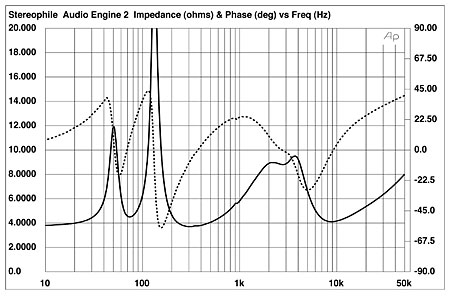
Fig.1 Audioengine2, electrical impedance (solid) and phase (dashed). (2 ohms/vertical div.)
However, the Audioengine2's amplifier does include equalization; fig.2 shows that it gradually boosts the output below 2kHz, reaching a maximum amplification of +9dB between 40 and 100Hz. The boost decreases to +4dB at 10Hz, but the 2.6"-diameter woofer will be driven into high excursions by music having anything much in the way of subsonic content. And the 9dB boost will result in highish low-frequency distortion when the speaker is played at high levels. Placing the speaker on a high stand in the middle of my listening room to reduce the effect of room modes on the measurement, setting the 2kHz playback level at 86dB at 12", then playing a tone at 127Hz resulted in audible distortion. The second and third harmonics both lay at –38dB (1.2%) with respect to the fundamental. Fig.3 shows that reducing the level by 10dB dropped the second harmonic to a more acceptable –44dB (0.6%), but the third harmonic remained at –40dB (1%). Repeating this test with a 61Hz tone at the higher playback level, where the required cone excursion will be more extreme, gave second and third harmonics at a very audible –32dB (2.5%) and –26dB (5%), respectively, with wind noise coming from the port. Again, reducing the playback level by 10dB reduced the level of the second harmonic, which now lay at –36dB (1.5%), but the third remained at –26dB. Given BJR's satisfaction with the Audioengine's low frequencies, I conjecture that the harmonic energy added by the non-linearity deceives the ear into thinking that there is more bass present than there really is, at last until the woofer reaches its end-stops!
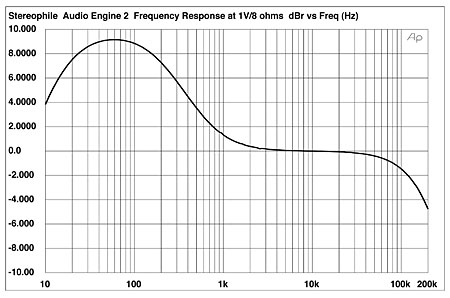
Fig.2 Audioengine2, built-in amplifier frequency response at 1V into 8 ohms, measured at right-channel speaker output jacks (2dB/vertical div.).
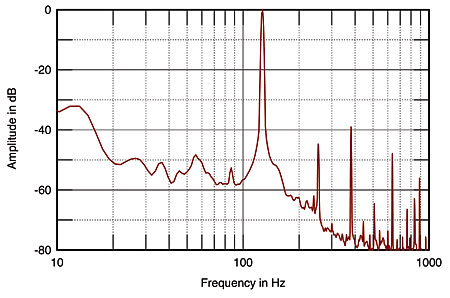
Fig.3 Audioengine2, spectrum of left speaker reproducing a 127Hz tone at 12". Playback level was 76dB spl at 2kHz (10dB/vertical div.).
All the acoustic measurements were performed on the left-channel speaker, driven by its internal amplifier with the equalization. It would be unusual if the tiny cabinet had any low-frequency panel resonances, and indeed, investigating the panels' vibrational behavior with an accelerometer uncovered only a single mode, at 477Hz (fig.4). This is high enough in frequency and low enough in level to be benign, I feel.
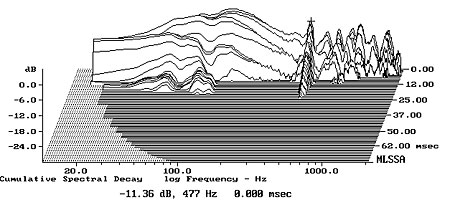
Fig.4 Audioengine2, cumulative spectral-decay plot calculated from the output of an accelerometer fastened to the center of the cabinet's side panel (measurement bandwidth, 2kHz).
The Audioengine2's farfield response, averaged across a 30° horizontal angle on its tweeter axis, is shown to the right of fig.5. The speaker is impressively flat and extended in the treble, though its upper midrange is shelved down by up to 5dB. The rise in measured output below 400Hz will partly be due to the nearfield measurement technique used in this region, but mainly reflects the equalization described above. The individual responses of the woofer (blue trace) and port (red) are shown, scaled in the ratio of the square roots of the radiating areas; the black trace in the bass is the sum of their outputs, taking into account acoustic phase. Even with the equalization, the speaker rolls off below 90Hz or so; but when used on a desktop, of course, it will benefit from some boundary reinforcement in this region.
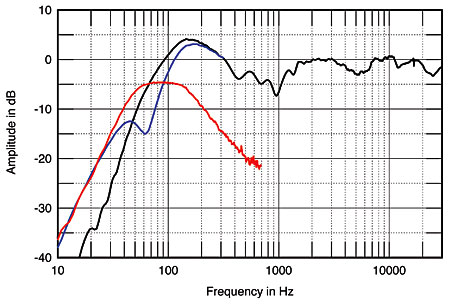
Fig.5 Audioengine2, anechoic response on tweeter axis at 50", averaged across 30° horizontal window and corrected for microphone response, with the nearfield responses of the port (red) and woofer (blue) plotted below 700 and 300Hz, respectively, and the complex sum of the nearfield responses plotted below 300Hz (black).
As can be expected from such a small speaker, the Audioengine2's lateral dispersion is wide and even (fig.6), though there is a slight but unexpected flare at the bottom of the tweeter's passband—unexpected because of the small diameter of the woofer, which, all things being equal, should maximize its radiation pattern at the top of its passband. The 20mm tweeter is less directional above 10kHz than a 1" dome would be. In the vertical plane (fig.7), a large suckout develops at what I assume is the crossover frequency, 3.6kHz, more than 5° above the tweeter axis, suggesting that the Audioengine2's owner sit on or below that axis. High stands or bookshelves will work best, or, if the speaker is used on a desktop, tilting it back a little would be worthwhile.
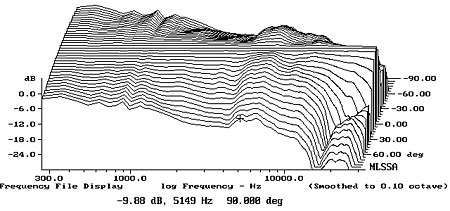
Fig.6 Audioengine2, lateral response family at 50", normalized to response on tweeter axis, from back to front: differences in response 90–5° off axis, reference response, differences in response 5–90° off axis.
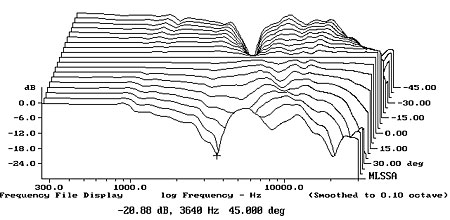
Fig.7 Audioengine2, vertical response family at 50", normalized to response on tweeter axis, from back to front: differences in response 45–5° above axis, reference response, differences in response 5–45° below axis.
In the time domain, the speaker's step response (fig.8) suggests that both drive-units are connected with positive acoustic polarity, though there is an odd bump in the step around 500s after the initial output of the woofer. A reflection from the cabinet's rear panel? A surround effect? Whatever, it is associated with the delayed energy seen between 500Hz and 1kHz in the Audioengine2's cumulative spectral-decay plot (fig.9). Other than that, this graph reveals a very clean initial decay, something generally associated with a grain-free treble presentation.
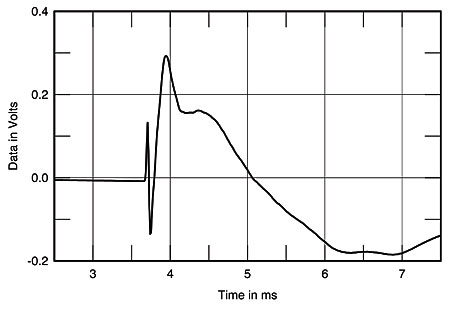
Fig.8 Audioengine2, step response on tweeter axis at 50" (5ms time window, 30kHz bandwidth).

Fig.9 Audioengine2, cumulative spectral-decay plot at 50" (0.15ms risetime).
I wasn't sure what to expect from the Audioengine2. My experience of the plastic desktop powered speakers sold for use with computers has been universally negative, and the Audioengine2 doesn't cost much more than those underachievers. I was impressed, however, both with the level of audio engineering it demonstrates and with the quality of its fit'n'finish. Yes, its distortion on high-level tones at low frequencies is no better than I would have expected, but for desktop use, this will be less of a factor than if the speakers were used in open space.—John Atkinson

What kind of connection are you using for the ipod - simply through the headphone jack or is there a better way to connect to these speakers?

This Stereophile review of the Audioengine A2's is very often referenced as the reason why many people bought the speakers, and it's easy to see why. The review is so enthusiastic that it almost reads like a passionate love letter, with the reviewer practically foaming at the mouth about how wonderful these speakers are.
For the most part, I agree with how good these speakers sound, but with one glaring exception. The review did not mention a word about the obviously excessive bloat of the bass at around 180Hz, which is about 6 dB too prominent and ruins the sonic signature. The bass bloat overshadows the rest of the frequency ranges and makes the speakers sound muddy and congested. 6 dB of bass bloat is not something you can just overlook--that is considered pretty severe coloration by the standards of audiophiles or pro audio. I for the life of me cannot understand why Robert J. Reina did not warn the readers about it--in fact, he vouched for how natural, accurate, and tight the bass was. So, either he has no idea what accurate/neutral/natural bass actually sounds like, or he chose not to talk about that flaw--either way, it makes me think twice about the credibility of Stereophile and its reviewers.

I agreed with Lunatique. I have a chance to place Audioengine A2 and Focal Book XS side by side for a comparison. A2 had a lot of bass, in fact, the bass was more than Focal's, and it also goes deeper(louder at 45hz); which is amazing for a much smaller speaker. BUT, it sounds not as good. In fact, the mid range was pretty muddy, lack lots of details; I would suspect there's an echo-plugin enabled for the vocals on A2s. The high's better than the mids, but still, it offered A LOT less detail and clarity than the Book XS. I feel that A2 sounded like watching an old SDTV; and XS was something between an HDTV and opening a window.
This speaker in my hand is definitely not "no coloration". Is it sound natual, yes, but it's somewhat muddy, warm, and tube like. It's enjoyable, just so different from what the review said here.

The reviewer is comparing a low end product with the likes of Audio Research amplification. One wonders if that is the right approach.

I've been using my AEGO 2 for years. The volume control is shot, often turning off the left channel. I considered the AEGO M but, of course, these are no longer available in the US. AE offered to send me an AEGO M (for $400) from UK which, they said, would work with a simple 220 to 120 volt converter.
Bottom line is that I need a decent, inexpensive powered speaker replacement to work with my iMac in a very small room. Best if they could be wall mounted and if they would have a separate input from my NAD CD player C 515BEE. (The AEGO 2 works with the NAD if I just unplug the subwoofer connection from the iMac) Choices seem to be Focal XS Book vs. Audioengine 2.
I would appreciate any input.
Best,
Marv

I really hate that the audio industry has turned into a lot of misrepresentations. It is done almoot reflexively at this point. From the Audioengine website FAQ:
"How can such small speakers have so much clean-sounding, deep, tight bass?
.... It's also worth mentioning that we don’t use any enhancement circuits to add fake bass, so what you’ll hear is real bass, really low and clean."
This review:
"As in the A2, a modest, 4.7dB boost centered on 80–100Hz is used to extend the acoustic output in the midbass, though this will reduce the dynamic range at low frequencies."
This is the definition of an enhancement circuit. I emailed Audioengine for clarification. No response. I owned the A2 and that bass bump was 6dB and it ruined the sound of that speaker, for anyone who is serious at this hobby.
Lies and more lies.